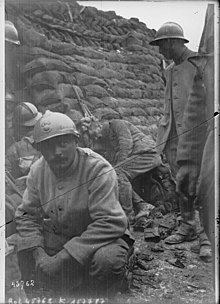53 e régiment d'infantry
|
Regiment d'Alsace |
|
|---|---|
 Internal association badge |
|
| active | May 1656 to January 1, 1920 |
| Country |
|
| Armed forces |
|
| Armed forces |
|
| Branch of service | infantry |
| Type | Infantry Regiment |
| Insinuation | 163 e division d'infanterie (163rd infantry division) |
| Location | Perpignan |
| Patron saint | Maurice d'Agaune |
| motto | “Plutôt mourir que faillir”, after 1757: “En avant, quand même”! |
| Awards | Croix de guerre 1914–1918 with two palm branches |

The 53 e régiment d'infanterie , temporarily also 53 e régiment d'infanterie de ligne , was a foreign regiment ( Régiment étrangère ) of the French army consisting of foreigners .
Lineup and significant changes
Before regiment numbering was introduced on January 1, 1791, it was last named Régiment d'Alsace in the royal French army .
Since the regiment was named after a region and not after its owner, the name did not change until the French Revolution.
- May 1656: Establishment of the regiment as Régiment d'Alsace , it was a so-called "German Regiment" (Régiment allemand) and consisted mainly of Germans or German-speaking soldiers.
- 1760: The German "Régiment de Bergh" was incorporated
- April 26, 1775: The 3rd battalion was transferred to the Régiment de Bouillon to set up a 2nd battalion .
- January 1, 1791: renamed 53 e régiment d'infanterie de ligne
- June 16, 1795: The 1st battalion was increased to 105 e demi-brigade d'infanterie de bataille
- The 2nd Battalion was merged with parts of colonial regiments from Cayenne and formed the 106 e demi-brigade d'infanterie de bataille
- 1870: A reserve regiment, the (Régiment de marche), the "53 e régiment de marche" was set up from parts of the regiment
- 1914: During the mobilization, the trunk of his reserve regiment was established from the regiment, the "253 e régiment d'infanterie"
- January 1, 1920: The regiment was disbanded.
Mestres de camp / Colonels
Mestre de camp was from 1569 to 1661 and from 1730 to 1780 the denomination of rank for the regiment holder and / or for the officer in charge of the regiment. The name "Colonel" was used from 1721 to 1730, from 1791 to 1793 and from 1803 onwards.
After 1791 there were no more regimental owners.
Should the Mestre de camp / Colonel be a person of the high nobility who had no interest in leading the regiment (such as the king or queen), the command was given to the "Mestre de camp lieutenant" (or “Mestre de camp en second”) or the “Colonel-lieutenant” or “Colonel en second”.
[...]
- July 27, 1809 - late 1811: Pierre André Grobon
[...]
- 1870: Lieutenant-Colonel Brémens
[...]
- 1914: Colonel Alfred-Louis-Achille Arbanère
[...]
Garrisons and operational history
Ancien Régime
- 1658 : Garrison in Strasbourg
War of Devolution (1667 - 1668)
War of the Palatinate Succession (1688–1697)
- 1690 : During the War of the Palatinate Succession , the regiment moved to Basse-Provence in order to relieve the citadel of Seyne, besieged by the Piedmontese, together with the militia . There was no fighting because the besiegers had withdrawn beforehand.
War of the Spanish Succession (1701-1713)
- 1705 : On July 18, the regiment defended the "Lignes de Flandre" in the brigade formation with the Régiment de La Marck
War of the Polish Succession (1733-1738)
- 1733 : On November 12th, the Régiment de Pons , the Régiment de La Marine and the Régiment de Royal-Bavière marched into the Margraviate of Baden to complete the work on the earthworks that were supposed to cover the bridge over the Rhine.
War of the Austrian Succession (1740–1748)
- 1741 : Defense of Písek . On December 18, the Austrians made a sudden attack on the suburb in front of the Budweiser Tor. They penetrated through the open barriers into the suburb, where they were greeted by the "l'Alsace" and the regiments La Marine and La Reine with murderous defensive fire from their houses. The attackers withdrew under cover of night. The next morning the Maréchal de Broglié sent a troop to observe the Austrians, consisting of 300 cavalrymen and four grenadier companies (two from “La Marine”, one from “La Reine” and one from “l'Alsace”). This troop acted very recklessly, was surrounded by the Austrian rearguard and destroyed
Seven Years War (1756–1763)
- 1760 : Battle of Kampen Monastery
Revolutionary Wars and the First Empire
- December 1, 1792: Assigned to the "Armée de Moselle" (Moselle Army) as a unit of the second line, participation in the campaign to Trier .
- Then transferred to the "Armée du Nord" (Northern Army)
- 1793: Assigned to the "Armée des Pyrénées orientales" (Eastern Pyrenees Army), Pyrenees War :
- Participation in the Battle of Peyrestortes
- Seconded to the Armée de Sambre-et-Meuse
- 1799: Assigned to the "Armée d'Helvétie" (Army in Switzerland):
- September 25 and 26, 1799: Second battle near Zurich
- 1800: With the Armée d'Italie
- Campaign in Tyrol
- 1805:
- Battle of Caldiero
- 1809:
- 1812: Russian campaign
1815-1848
- 1840: Commanded to Algeria, the regiment was under the command of the later Marshals Saint-Arnaud and Bosquet for the next nine years . It earned the respect of the enemy, the men of Abd el-Kader
- August 16, 1844: Battle of Isly (Morocco)
Second republic
- 1849: Campaign to Rome to suppress the Roman Republic
Second empire
- 1856: Garrison in Nogent and Auxerre
- 1858–1860: Garrison in Lons-le-Saunier
- June 24, 1859: Battle of Solferino
- 1861–1862: Garrison in Besançon
- 1863: Garrison in Givet . A battalion was in Reims
- Franco-German War
On August 1, the regiment was assigned to the Armée du Rhin (Rhine Army). Together with the 89 e régiment d'infantry , it was the second infantry brigade under General de La Bastide. together with the 1st Infantry Brigade of Général Guiomar, two field artillery batteries with four guns each, a battery Mitrailleusen and a pioneer company, the 2nd Infantry Division under Général de division Liébert. This division was under the 7th Army Corps of Général de division Felix Douay.
- September 1, 1870: Used in the Battle of Sedan
1871-1914
- 1871: Garrison in Tarbes
- Parts of the regiment were sent to Algeria and Madagascar .
- 1907: Garrison in Perpignan . Two companies were in Mont-Louis (Eastern Pyrenees), one in Collioure and another in Fort de Bellegarde on the Col du Perthus near Le Perthus
First World War
Subject to:
- 124 e division d'infanterie (124th infantry division) from June 1915 to November 1916
- 163 e division d'infanterie (163rd Infantry Division) from November 1916 to November 1918 1918
1914
- Fight in the Battle of Mörchingen , Battle of the Trouée de Charmes , September 4th - 13th near Nancy, Battle of the Grand Couronné , and the First Battle of Flanders near Ypres.
The regimental commander, Colonel Alfred-Louis-Achille Arbanère, died on August 20, 1914 from the wound he received in the fighting for Rorbach-lès-Dieuze .
1915
- September 28th to November 6th: Autumn battle in Champagne , fighting at Fort de Beauséjour
1916
- Battle of Verdun , fighting at Fort de Vaux
1917
- Fight at Les Éparges, Mont-Haut and in the Caurières forest
1918
- Defensive battles on the Somme The counter-offensive begins on July 15th.
Special honor
- Order n ° 17.356 D4 du GQG of May 15, 1919.
Bataille Germain, Adjudant-Chef der Reserve in the 2nd Company of the 53rd Infantry Regiment, elite sergeant and instructor, had spontaneously assumed a position held by the enemy at the head of some of his men during the heavy fighting on July 15, 1918. During this action he was badly wounded and lost his right eye. He was made a Knight of the Legion of Honor .
post war period
After the armistice of November 11, 1918, the regiment stayed in the Ardennes for a few days and then moved to the Belgian-French border. In March 1919, it was located in Compiègne and began to reduce its staff. Most of the reservists have already been released. In Hazebrouck , the regimental flag was then given the glorious names of the battles of Champagne, Verdun and Noyon in a military ceremony. In addition, the unit received the Fourragère with the colors of the Croix de guerre 1914-1918.
After the regiment had been garrisoned in Tarn for some time, it was ordered back to Perpignan, where it was received triumphantly by the population.
Ultimately, it fell victim to force reduction and disbanded on January 1, 1920.
Regimental flag
On the back of the regimental flag (since Napoleonic times) the campaigns and battles in which the regiment took part are listed in gold letters.
Decorations
- The flag ribbon is decorated with the Croix de guerre 1914–1918 with two palm branches (two honorable mention in the army order)
- The relatives have the right to wear the Fourragère in the colors of the Croix de guerre 1914–1918.
Motto
(Better to die than fail)
- after 1757:
(Forward no matter how)
Known members of the regiment
- Pierre Hugues Victoire Merle
- 1790: Général Nicolas Dahlmann
- 1830: Général de division Eugène Casimir Lebreton (1791–1876)
- (André) Georges Schimberg, pastor in Mailly-Champagne, died as a regimental chaplain for France on November 4, 1918.
Uniforms of the Ancien Régime
literature
- À partir du Recueil d'Historiques de l'Infanterie Française (Général Andolenko - Eurimprim 1969).
Web links
Footnotes
- ↑ Fiche sur geneanet . Retrieved March 5, 2013.
- ↑ Guy Silve, "Seyne-les-Alpes et sa citadelle", in Amis des forts Vauban de Colmar et Association Vauban, Vauban et ses successeurs dans les Alpes de Haute-Provence, Association Vauban, Paris, 1992, p. 82
- ↑ « Décision n ° 12350 / SGA / DPMA / SHD / DAT du 14 September 2007 relative aux inscriptions de noms de batailles sur les drapeaux et étendards des corps de troupe de l'armée de terre, du service de santé des armées et du service des essences des armées, Bulletin officiel des armées, n ° 27, 9 November 2007 »(German:“ Provision n ° 12350 / SGA / DPMA / SHD / DAT of September 14, 2007 on the appearance of the inscriptions on the flags and standards of the Troops of the army, the medical service and the fuel supply branch. Published with the official army bulletin No. 27 of November 9, 2007 ")
- ↑ " Arrêté relatif à l'attribution de l'inscription AFN 1952–1962 sur les drapeaux et étendards des formations des armées et services, du 19 novembre 2004 (A) NORDEF0452926A Michèle Alliot-Marie " (German: "Order AFN 1952–1962 on the assignment of the inscriptions on the flags and standards of the formations of the army and the services of November 19, 2004 (A) NORDEF0452926A Michèle Alliot-Marie ")
- ↑ This also applies to units that have already been disbanded, as they can (theoretically) be put back into active service at any time
- ↑ There is a commemorative plaque in the Saint-Sixte monastery in Reims.












